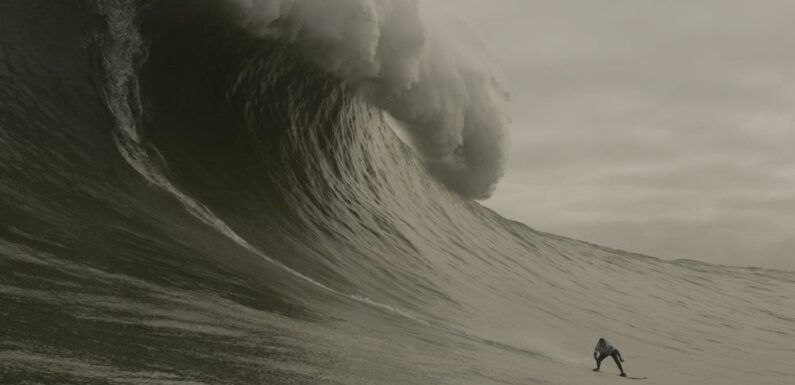
Though the field of women’s athletics has evolved and expanded considerably in recent years, it still seems well-nigh impossible for even the most elite competitors to get more than a tiny fraction of the recognition routinely accorded star sportsmen. That equation certainly seems borne out in “Maya and the Wave,” Stephanie Johnes’ portrait of leading female big wave surfer Maya Gabeira. This festival favorite (which premiered at the Toronto Film Festival before kicking off Doc NYC) has some gaps in storytelling and contextualization that leave it feeling like a less-than-complete picture of the protagonist’s career to date. Yet the film more than succeeds in its primary goals of providing an inspirational role model plus lots of stupendous surfing footage, a combination that will enthrall most viewers.
It opens with majestic waves nearly 100 feet high breaking off resort town Nazare on Portugal’s western coast. In addition to being her current home, this has been the location of the now 35-year-old Gabeira’s greatest triumphs — and her single greatest setback. Born and raised in Rio, she started surfing at 13, competing at 15, then turned pro at 17. She “went from zero to 100 in a year” in terms of endorsements, prizes and other high-profile perks, according to fellow Brazilian Carlos Burle, her first major mentor and coach. Nonetheless, his wisdom was doubted by many when he first made her part of a tow-in big wave team.
What we see onscreen is always involving. But in her first directorial feature in 15 years, cinematographer Johnes doesn’t organize this material with ideal cogency. A timeline of Gabeira’s achievements is poorly delineated in the editing, so we hear male surfers doubting her abilities after it seems she’s already proven herself by winning many championships. Is this simple sexism, or does the film omit incidents that would explain their skepticism? Nor are other women pro surfers ever heard from, which not only limits the film’s perspective but gives the distorted impression that the subject remains a sole representative of her gender in the big-wave sphere.
The key event that naysayers took as “proof” was a near-fatal wipeout at Nazare in 2013 — no less than Laird Hamilton publicly declared, “Maya does not have the skills to be in these kinds of conditions.” It was considered a small miracle that Burle was even able to get her to shore alive (if barely), and a long spell of hospitalization, surgeries, chronic pain and forced rest ensued. But while many expected that to be the end, her always-intense commitment to training orchestrated a recovery and comeback that ultimately found her back at Nazare. There, she rode the biggest wave any woman had surfed — then broke that record again two years later, via the biggest wave ridden by anyone in 2020, male or female.
Like many pro athletes, Gabeira seems so wholly focused on her sport, there’s not much else to read from her apparently pleasant, unpretentious personality — either that, or she’s just very good at presenting a relatable surface to the omnipresent cameras. We get a limited glimpse of her personal life, notably a privileged family background. (Her father Fernando Gabeira is one of Brazil’s most celebrated figures of politics and letters, a chapter of whose own story became Bruno Barreto’s Oscar-nominated 1997 dramatic feature “Four Days in September.”) She finds a professional and private partner in Sebastian Steudtner, another top-ranked big wave surfer. His supportiveness is painted as a contrast to the association with Burle, another aspect here whose complexities are left rather murky.
It’s difficult to sort the contradictions in that platonic relationship from what either side says, as Gabeira is vague on the subject, while Burle alternately seems her loyal booster and a surprisingly critical voice in interview clips of unclear chronology. Certainly it’s striking when he describes her attributes in terms not just athletic but somewhat crassly looks-evaluative — a sexualized gaze amplified by some of her sports media and endorsement-deal imagery. Many were also taken aback when after dragging her unconscious to the beach at Nazare, he simply left her to medicos and went back out to surf. Such discordant notes raise questions that “Maya and the Wave” prefers to sidestep.
For her part, Gabeira shrugs “I’m a woman in a man’s world” … but it seems unlikely those male colleagues would disarmingly admit that big-wave surfing “would not be exhilarating if I wasn’t really scared.” The drive that pushes her past fear is less tangible out of the water, though it does manifest when she’s so exasperated by her above-noted records failing to get into the Guinness Book that she mounts a public petition to demand they institute a women’s category for biggest wave surfed.
Presumably drone photography — as well as the still-relatively-recent phenomenon of big-wave riding itself — can be credited for the kind of jaw-dropping shots that used to be precious and rare in surfing documentaries, but now appear regularly. They’re no less impressive for their greater frequency, however. Johnes and three other camera operators capture numerous sequences in which the juxtaposition of tiny wet-suited human and mammoth-wave inspires awe, as well as a certain primal terror. Elsewhere, the documentary’s production values are also first-rate, though an original score of indie dreampop-style rock by Turtle is a bit soporific as accompaniment to such dazzling visuals.
Read More About:
Source: Read Full Article